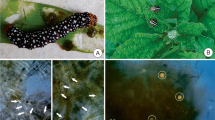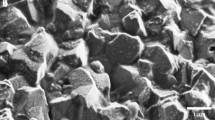Abstract
Main conclusion
Calcium phosphate was unknown as a plant biomineral until recently reported in Neotropical Loasaceae. Here, we demonstrate its widespread occurrence in the trichomes of several plant families, including Brassicaceae.
Calcium phosphate is the primary biomineral in, e.g., the bones and teeth of higher animals; in plants, it was only recently discovered in the stinging hairs and scabrid–glochidiate trichomes of South American Loasaceae (Ensikat et al. in Sci Rep UK 6:26073, 2016), where it appears to be deposited highly specifically, often replacing the common plant biomineral silica. We initiated a broader survey in a range of different plant orders to investigate a possibly wider distribution of calcium phosphate biomineralization in plants. Scanning electron microscopy with EDX element analysis and mapping was used for the detection of the biominerals: calcium phosphate, calcium carbonate, and silica in the trichomes of several common plant species of different orders. Results were authenticated with Raman spectroscopy. Calcium phosphate was found in the trichomes of several species in the orders Malpighiales, Rosales, Boraginales, and Brassicales. It occurred in trichome tips, replacing the more common silica, or together with silica and calcium carbonate at specific locations in the trichome cell walls. Most surprisingly, it was found in the trichomes of Arabidopsis thaliana, one of the most studied plant species—where it had been overlooked so far. The wide distribution of calcium phosphate as plant biomineral here demonstrated and the striking mineralization patterns with three different biominerals in the walls of single-celled trichomes underscore an unexpected complexity in plant biomineralization.






Similar content being viewed by others
Abbreviations
- BSE:
-
Backscattered electron
- EDX:
-
Energy dispersive X-ray analysis
- SE:
-
Secondary electron
- SEM:
-
Scanning electron microscopy
References
Bloomer RH, Lloyd AM, Symonds VV (2014) The genetic architecture of constitutive and induced trichome density in two new recombinant inbred line populations of Arabidopsis thaliana: phenotypic plasticity, epistasis, and bidirectional leaf damage response. BMC Plant Biol 14:119
Cordell D, Jackson M, White S (2013) Phosphorus flows through the Australian food system: identifying intervention points as a roadmap to phosphorus security. Environ Sci Policy 29:87–102
Ensikat HJ, Weigend M (2013) Cryo-scanning electron microscopy of plant samples without metal coating, utilizing bulk conductivity. Microsc Anal 27:7–10
Ensikat HJ, Geisler T, Weigend M (2016) A first report of hydroxylated apatite as structural biomineral in Loasaceae—plants’ teeth against herbivores. Sci Rep UK 6:26073
Ensikat HJ, Mustafa A, Weigend M (2017) Complex patterns of multiple biomineralization in single-celled plant trichomes of the Loasaceae. Am J Bot 104:195–206
Franceschi VR, Nakata PA (2005) Calcium oxalate in plants: formation and function. Annu Rev Plant Biol 56:41–71
George TS, Hinsinger P, Turner BL (2016) Phosphorus in soils and plants—facing phosphorus scarcity. Plant Soil 401:1–6
Guidry MW, Mackenzie FT (2000) Apatite weathering and the Phanerozoic phosphorus cycle. Geology 28:631–634
Handley R, Ekbom B, Ågren J (2005) Variation in trichome density and resistance against a specialist insect herbivore in natural populations of Arabidopsis thaliana. Ecol Entomol 30:284–292
Harpole WS, Stanley CJ (2016) Addition of multiple limiting resources reduces grassland diversity. Nature 537:93–96
Hauser MT (2014) Molecular basis of natural variation and environmental control of trichome patterning. Front Plant Sci 5:20–26
He H, Veneklaas EJ, Kuo J, Lambers H (2014) Physiological and ecological significance of biomineralization in plants. Trends Plant Sci 19:166–174
Kaur G, Prabhavathi V, Bamel K, Sarwat M (2016) Phosphate signaling in plants: biochemical and molecular approach. In: Sarwat M, Abdin AAMZ, Ibrahim MM (eds) Stress signaling in plants: genomics and proteomics perspective, vol 2. Springer, Berlin, pp 83–110
Küpper H, Lombi E, Zhao FJ, McGrath SP (2000) Cellular compartmentation of cadmium and zinc in relation to other elements in the hyperaccumulator Arabidopsis halleri. Planta 212:75–84
Lanning FC, Eleuterius LN (1987) Silica and ash in native plants of the central and southeastern regions of the United States. Ann Bot 60:361–375
Lin ML, Yen TB, Kuo-Huang LL (2004) Formation of calcium carbonate deposition in the cotyledons during the germination of Justicia procumbens L. (Acanthaceae) seeds. Taiwania 49:250–262
Løe G, Toräng P, Gaudeul M, Ågren J (2007) Trichome production and spatiotemporal variation in herbivory in the perennial herb Arabidopsis lyrata. Oikos 116:134–142
Lowenstam HA (1981) Minerals formed by organisms. Science 211:1126–1131
Mustafa A, Ensikat HJ, Weigend M (2017) Ontogeny and the process of biomineralization in the trichomes of Loasaceae. Am J Bot 104:367–378
Oldroyd GE, Harrison MJ, Paszkowski U (2009) Reprogramming plant cells for endosymbiosis. Science 324:753–754
Sletvold N, Huttunen P, Handley R, Kärkkäinen K, Ågren J (2010) Cost of trichome production and resistance to a specialist insect herbivore in Arabidopsis lyrata. Evol Ecol 24:1307–1319
Smith MP, Harper DA (2013) Causes of the Cambrian explosion. Science 341:1355–1356
Traw MB, Bergelson J (2003) Interactive effects of jasmonic acid, salicylic acid, and gibberellin on induction of trichomes in Arabidopsis. Plant Physiol 133:1367–1375
Vance CP, Uhde-Stone C, Allan DL (2003) Phosphorus acquisition and use: critical adaptations by plants for securing a nonrenewable resource. N Phytol 157:423–447
Zhou LH, Liu SB, Wang PF, Lu TJ, Xu F, Genin GM, Pickard BG (2016) The Arabidopsis trichome is an active mechanosensory switch. Plant Cell Environ 40:611–621
Acknowledgements
The authors thank T. Jossberger for vouchering the collection. We thank Prof. Dr. Thorsten Geisler-Wierwille for his assistance in collecting the Raman spectra.
Author information
Authors and Affiliations
Corresponding author
Ethics declarations
Conflict of interest
The authors declare no competing financial interests.
Electronic supplementary material
Below is the link to the electronic supplementary material.
Rights and permissions
About this article
Cite this article
Weigend, M., Mustafa, A. & Ensikat, HJ. Calcium phosphate in plant trichomes: the overlooked biomineral. Planta 247, 277–285 (2018). https://doi.org/10.1007/s00425-017-2826-1
Received:
Accepted:
Published:
Issue Date:
DOI: https://doi.org/10.1007/s00425-017-2826-1




